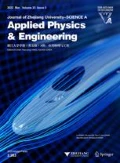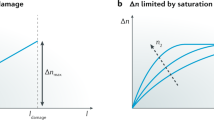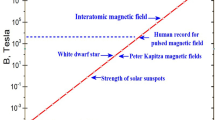Abstract
The theoretical mechanism for realizing a negative refractive index material in an optical frequency range with an atomic gas system of electromagnetically induced transparency (EIT) is studied. It is shown that under certain conditions such a dense gas can exhibit simultaneously negative permittivity and negative permeability, and negligibly small loss.
Similar content being viewed by others
References
Chen, L., He, S., Shen, L., 2004. Finite-size effects of a left-handed material slab on the image quality.Phys. Rev. Lett.,92:107404-(1-4)–107404-4.
Cowan, R.D., 1981. The Theory of Atomic Structure and Spectra. Univ. of California Press. Berkeley, Calif., Appendix D, p.640.
Davanco, M., Holmström P., Blumenthal, D.J., Thylén, L., 2003. Directional coupler wavelength filters based on waveguides exhibiting electromagnetically induced transparency.IEEE J. Quantum Electron,39:608–613.
Grbic, A., Eleftheriades, G.V., 2004. Overcoming the diffraction limit with a planar left-handed transmission-line lens.Phys. Rev. Lett.,92:117403-(1-4)–117403-4.
Harris, S.E., 1997. Electromagnetically induced transparency.Phys. Today,50(7):36–42.
Jackson, J.D., 2001. Classical Electrodynamics, 3rd Ed., Wiley, New York, p. 158–162.
Li, Y.Q., Xiao, M., 1995. Transient properties of an electromagnetically induced transparency in three-level atoms.Opt. Lett.,20:1489–1491.
Pendry, J.B., 2000. Negative refraction makes a perfect lens.Phys. Rev. Lett.,85:3966–3969.
Schmidt, H., Imamoĝlu, A., 1996. Giant Kerr nonlinearities obtained by electromagnetically induced transparency.Opt. Lett.,21:1936–1938.
Scully, M.O., Zubairy, M.S., 1997. Quantum Optics. Cambridge Univ. Press, Cambridge, See. 7.
Shelby, R.A., Smith, D.R., Schultz, S., 2001. Experimental verification of a negative index of refraction.Science,292:77–79.
Author information
Authors and Affiliations
Corresponding author
Additional information
Project supported by the National Natural Science Foundation (NSF) of China (Nos. 90101024 and 60378037), and the National Basic Research Program (973) of China (No. 2004CB719805)
Rights and permissions
About this article
Cite this article
Shen, Jq., Ruan, Zc. & He, Sl. How to realize a negative refractive index material at the atomic level in an optical frequency range?. J. Zheijang Univ.-Sci. 5, 1322–1326 (2004). https://doi.org/10.1631/jzus.2004.1322
Received:
Revised:
Published:
Issue Date:
DOI: https://doi.org/10.1631/jzus.2004.1322
Key words
- Negative refractive index
- Left-handed medium
- Electromagnetically induced transparency
- Atomic level
- Optical frequency




